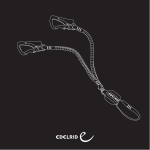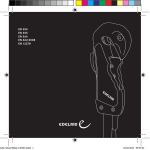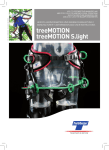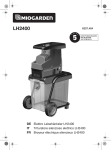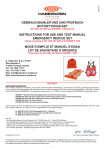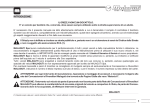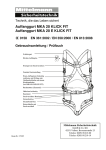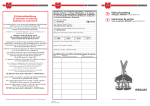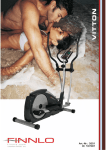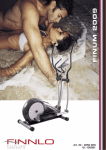Download EN 361 EN 358 EN 813 EN 1497 EN 1498 EN 12277 EDELRID
Transcript
XXXXXX EN 361 EN 358 Dieses EN 813Produkt ist Teil einer Persönlichen Schutzausrüstung EN 1497 (PSA) und sollte einer Person zugeordnet werden. EN 1498 Diese Gebrauchsanleitung beinhaltet wichtige HinEN 12277 weise (Industrieschutzhelme nach EN 397: Zusätzlich XXXXXXX Anwendung. Sie können jedoch niemals Erfahrung, Eigenverantwortung und Wissen über die beim Bergsteigen, Klettern und Arbeiten in der Höhe und Tiefe auftretenden Gefahren ersetzen und entbinden nicht vom persönlich zu tragenden Risiko. eine Kontrollkarte und einen Überprüfungsnachweis). Vor der Verwendung dieses Produktes müssen alle Dokumente inhaltlich verstanden worden sein.Diese Unterlagen sind dem Benutzer in der Sprache des Bestimmungslandes durch den Wiederverkäufer zur Verfügung zu stellen und müssen während der gesamten Nutzungsdauer bei der Ausrüstung gehalten werden. Anwendungshinweise Die folgenden Anwendungshinweise sind sorgfältig durchzulesen und unbedingt zu beachten. Dieses speziell für das Bergsteigen, Klettern und Arbeiten in der Höhe und Tiefe hergestellte Produkt entbindet bei der Nutzung nicht vom persönlich zu tragenden Risiko. Bergsteigen, Klettern und Arbeiten in der Höhe und Tiefe beinhalten oft nicht erkennbare Risiken und Gefahren durch äußere Einflüsse. Unfälle können nicht ausgeschlossen werden. Um maximale Sicherheit beim Bergsteigen, Klettern und Arbeiten in der Höhe und Tiefe zu erzielen, ist eine sachgerechte Anwendung nur mit normenkonformer Ausrüstung möglich. Detaillierte und umfangreiche Informationen können der entsprechenden Fachliteratur entnommen werden. Die folgenden Gebrauchsinformationen sind wichtig für sach- und praxisgerechte EDELRID 88316 Isny im Allgäu Germany Tel. +49 (0) 7562 981 - 0 Fax +49 (0) 7562 981 - 100 [email protected] www.edelrid.de EN 361, EN 358, EN 813, EN 12277, EN 1497, EN 1498 0123 Prüfstelle: TÜV Product Service GmbH, D-80339 München 0299 Prüfstelle: FA Persönliche Schutzausrüstung, D-42781 Haan 0511 Prüfstelle: STP der AUVA, A-1201 Wien PSA-Richtlinie /PPE-Guideline / EPI-directive 89/686/(EWG/EEC/CEE) E-500530-000 05.08 Made in Germany. DE ARBEITSSICHERHEITSGURTE; HOCHSEILGARTENGURTE; RETTUNGSGURTE UND -SCHLAUFEN ARBEITSSICHERHEITSGURTE: Auffanggurt nach EN 361, Haltegurt nach EN 358, Sitzgurt nach EN 813, Arbeitssicherheitsgurt mit zusätzlicher Zertifizierung nach EN 12277 HOCHSEILGARTENGURT nach EN 361 und/oder EN 12277 und/oder EN 358 RETTUNGSGURT nach EN 1497 RETTUNGSSCHLAUFE nach EN 1498 HINWEISE ZUR ANWENDUNG, SICHERHEIT, LEBENSDAUER, LAGERUNG UND PFLEGE Arbeitssicherheitsgurte, Hochseilgartengurte: Dieses Produkt ist Teil einer Persönlichen Schutzausrüstung zum Schutz gegen Stürze aus der Höhe (PSA) und sollte einer Person zugeordnet werden. Rettungsgurte und –schlaufen: Dieses Produkt kann in der Anwendung Teil einer Persönlichen Schutzausrüstung zum Schutz gegen Stürze aus der Höhe sein. Diese Gebrauchsanleitung beinhaltet wichtige Hinweise, eine Kontrollkarte und einen Überprüfungsnachweis. Vor der Verwendung dieses Produktes müssen alle Dokumente inhaltlich verstanden worden sein. Diese Unterlagen sind dem Benutzer in der Sprache des Bestimmungslandes durch den Wiederverkäufer zur Verfügung zu stellen und müssen während der gesamten Nutzungsdauer bei der Ausrüstung gehalten werden. ANWENDUNGSHINWEISE Die folgenden Anwendungshinweise sind sorgfältig durchzulesen und unbedingt zu beachten. Dieses speziell für das Arbeiten in der Höhe und Tiefe hergestellte Produkt entbindet bei der Nutzung nicht vom persönlich zu tragenden Risiko. Arbeiten und Sport in der Höhe und Tiefe sind potenziell gefährlich. Fehler und Unachtsamkeiten können schwere Verletzungen oder sogar den Tod zur Folge haben. Die richtige Wahl der Ausrüstung erfordert Erfahrung und ist durch eine Gefahrenanalyse zu ermitteln, die Anwendung ist nur ausgebildeten und erfahrenen Personen oder unter Anleitung und Aufsicht gestattet. Der Anwender sollte sich darüber bewusst sein, dass bei nicht geeigneter körperlicher und / oder geistiger Verfassung Beeinträchtigungen der Sicherheit im Normal- und im Notfall auftreten können. Der Hersteller lehnt im Fall von Missbrauch und/oder Falschanwendung jegliche Haftung ab. Die Verantwortung und das Risiko tragen in allen Fällen die Benutzer bzw. die Verantwortlichen. Für die Anwendung dieses Produktes empfehlen wir, zusätzlich die entsprechenden nationalen Regeln zu beachten. Vor der Benutzung der Ausrüstung hat der Anwender sicherzustellen, dass im Falle eines Sturzes in das PSA-System eine unverzügliche, sichere und effektive Rettung der aufgefangenen Person erfolgen kann. PSA-Produkte sind ausschließlich zur Sicherung von Personen zugelassen. Auffanggurte nach EN 361: Das sichere Verbinden des Gurtes mit einem Rettungs- oder Auffangsystem erfolgt an den Auffangösen (A), die ggf. zur Anwendung kommenden einzelnen Verbindungselemente (Karabiner) müssen der EN 362 entsprechen und werden an diesen (A) befestigt. In einem Auffangsystem darf nur ein Auffanggurt nach EN 361 benutzt werden! Vor dem Einsatz eines Auffangsystems ist sicherzustellen, dass der erforderliche Freiraum am Arbeitsplatz unterhalb des Benutzers gewährleistet ist. Auffanggurte, die fest in Bekleidung integriert sind: Das Anlegen des Gurtes erfolgt mit dem Anziehen der Bekleidung. Bei Hosen ist die Passform der Beinschlaufen durch die Auswahl der Hosenkonfektionsgröße gegeben. Die weitere Passform ist wie unten angegeben vorzunehmen. Ein in einer Arbeitshose „schwer entflammbar“ integrierter Gurt darf nur zusammen mit einer geeigneten Schutzjacke genutzt werden. Sitzgurte nach EN 813: Bei Sitzgurten wird das Verbindungselement an der zentralen Halteöse befestigt. Bei Einsatz in Kombination mit einem Brustgurt (nach EN 12277) ist folgendes zu beachten: Die Nutzung eines Brustgurtes wird von dem in dieser Arbeitstechnik ausgebildeten Anwender über die zu erstellende Gefahrenanalyse bestimmt. Das Tragen eines Brustgurtes erhöht den Tragekomfort durch die Stützfunktion des Oberkörpers. Die Gebrauchsanleitung des Brustgurtes ist zu beachten. Ein Brustgurt darf niemals ohne einen Sitzgurt verwendet werden, Lebensgefahr! Achtung! Sitzgurte sind nicht für Auffangzwecke geeignet! Haltegurte nach EN 358: Verbindungselemente sind an den seitlichen Halteösen zu befestigen, die seitlichen Halteösen dürfen ausschließlich nur für Haltezwecke verwendet werden. Das Verbindungsmittel für Haltegurte ist straff zu halten, der Anschlagpunkt muss sich oberhalb oder in Hüfthöhe befinden und die freie Fallhöhe ist auf maximal 0,5 m zu begrenzen. Bei Haltegurten mit hinterer Rückhalteschlaufe ist folgendes unbedingt zu beachten: Die hintere Rückhalteschlaufe ist keine Halteöse zur Arbeitsplatzpositionierung nach EN 358 und auch keine Auffangöse! Sie dient zusammen mit einem entsprechenden Verbindungsmittel ausschließlich zur Wegbegrenzung, damit der Benutzer nicht in einen absturzgefährdeten Bereich gelangen kann (Rückhalten). Ggf., je nach Modell, kann ein Haltegurt in einen Auffanggurt (typabhängig) nach EN 361 integriert werden, hierbei ist die Kennzeichnung zu beachten. Achtung! Haltegurte sind nicht für Auffangzwecke geeignet! Rettungsausrüstung nach EN 1497 und EN 1498: Die Rettungsausrüstung darf nur als Bestandteil von Rettungssystemen verwendet werden, siehe auch Abbildungen. Rettungsgurte, die fest in Bekleidung integriert sind: Das Anlegen des Gurtes erfolgt mit dem Anziehen der Bekleidung. Bei Hosen ist die Passform der Beinschlaufen durch die Auswahl der Hosenkonfektionsgröße gegeben. Die weitere Passform ist wie unten angegeben vorzunehmen. Ein in einer Arbeitshose „schwer entflammbar“ integrierter Gurt darf nur zusammen mit einer geeigneten Schutzjacke genutzt werden. Gurte mit „Sliding-D-Band“ (z.B. Baumpflegegurt): Bei Gurten mit integrierten „Sliding-D-Band“ ist dieses bei der Nutzung einem erhöhten Verschleiß ausgesetzt. Wenn das Band starke Abnutzungserscheinungen (Faserbrüche, ausgefranste oder eingerissene Bandkanten etc.) zeigt, muss das „SlidingD-Band“ aus sicherheitstechnischer Sicht ersetzt werden. Der Tausch darf nur mit dem EDELRID Sliding-D Austausch-Set vorgenommen werden. Diesem Austausch-Set liegen alle benötigten Bauteile und eine Einbauanleitung bei. Der Einbauanleitung ist unbedingt Folge zu leisten, ansonsten besteht Lebensgefahr! Hochseilgarten- / Adventureparkgurte: Das sichere Verbinden des Gurtes mit einem Seil erfolgt durch einen Achterknoten an der Einbindeöse, dieser ist während des Gebrauches regelmäßig zu kontrollieren. Bei der Verwendung anderer Systeme (z.B. Verbindungsmittel oder Klettersteigsets) sind diese durch eine geeignete Verbindungstechnik, wie z.B. Ankerstich (siehe Abb.) oder Karabiner nach EN 12275 bzw. EN 362, mit der Einbindeöse zu verbinden. Hochseilgärten / Adventureparks Achtung: Die in das Hochseilgarten-/Adventureparksystem eingeleitete Kraft darf 6 kN nicht überschreiten! Materialschlaufen sind nicht zum Anschlagen bzw. Sichern zu benutzen! Anpassung und Größeneinstellung (alle Gurtarten, siehe auch Abbildungen) Vor dem ersten Gebrauch muss die Passform, und bei verstellbaren Gurten die entsprechende Größeneinstellung (diese erfolgt durch Betätigen der Verstellschnallen), in einem Hängetest an einem sicheren Ort überprüft werden. Die Größenauswahl bzw. –einstellung darf die erforderliche Bewegungsfreiheit in keiner Weise beeinträchtigen. Der angelegte Gurt muss bequem sitzen. Bei richtiger Größenauswahl bzw. –einstellung dürfen bei einem zehnminütigen Hängetest keinerlei Behinderung der Atmung und/oder Schmerzen auftreten. Bei angelegtem Gurt sind Beschlagteile im Bereich der Genitalien und unter den Achselhöhlen zu vermeiden. Das freie Hängen im Gurt darf keine übermäßige Hohlkreuzbildung, Überstreckung oder Druck auf die Genitalien, Lenden und Achselbereiche erzeugen. Bei Frauen müssen die lymphatischen Gefäße der Brust so weit wie möglich entlastet sein. Alle Einstellteile sind während der Benutzung regelmäßig zu überprüfen. ANSCHLAGPUNKT Um hohe Belastungen und Pendelstürze bei einem Sturz zu vermeiden, müssen Anschlagpunkte zur Sicherung immer möglichst senkrecht über der zu sichernden Person liegen. Das Verbindungsmittel vom Anschlagpunkt zur gesicherten Person ist immer so straff wie möglich zu halten. Schlaffseilbildung muss vermieden werden! Der Anschlagpunkt muss so gestaltet sein, dass beim Fixieren eines Verbindungsmittels keine festigkeitsmindernden Einflüsse auftreten können und es während der Benutzung nicht beschädigt wird. Scharfe Kanten, Grate und Abquetschungen können die Festigkeit stark beeinträchtigen, ggf. sind diese durch geeignete Hilfsmittel abzudecken. Der Anschlagpunkt und die Verankerung müssen den im ungünstigsten Fall zu erwartenden Belastungen standhalten. Auch bei der nach der EN 363 (Auffangsysteme) vorgeschriebenen Verwendung von Falldämpfern (nach EN 355) sind die Anschlagpunkte für Auffangkräfte von mind. 10 kN auszulegen, siehe auch EN 795. Bei der Verwendung eines Verbindungsmittels ist darauf zu achten, dass das Verbindungsmittel eine maximale Gesamtlänge von 2,0 m einschließlich Falldämpfer und Verbindungselemente nicht überschreiten darf. SICHERHEITSHINWEISE Bei Kombination dieses Produktes mit anderen Bestandteilen besteht die Gefahr der gegenseitigen Beeinträchtigung der Gebrauchssicherheit. Wird dieses Produkt in Verbindung mit anderen Bestandteilen eines Rettungs-/Auffangsystems genutzt, muss sich der Anwender vor Gebrauch über die beigefügten Empfehlungen, Hinweise und Anleitungen dieser Bestandteile informieren und diese einhalten. Die Benutzung sollte grundsätzlich nur in Verbindung mit CE- gekennzeichneten Bestandteilen von Persönlicher Schutzausrüstung (PSA) zum Schutz gegen Stürze aus der Höhe erfolgen. Wenn Originalbestandteile des Produktes verändert oder entfernt werden, können die Sicherheitseigenschaften dadurch eingeschränkt werden. Die Ausrüstung sollte in keiner Weise, die nicht vom Hersteller schriftlich empfohlen wird, verändert oder für das Anbringen von Zusatzteilen angepasst werden. Vor und nach dem Gebrauch ist das Produkt auf eventuelle Beschädigungen zu überprüfen, der gebrauchsfähige Zustand und sein richtiges Funktionieren ist sicherzustellen. Das Produkt ist sofort auszusondern, wenn hinsichtlich seiner Gebrauchssicherheit auch nur der geringste Zweifel besteht. Achtung! Die Produkte dürfen keinen schädigenden Einflüssen ausgesetzt werden. Darunter fallen die Berührung mit ätzenden und aggressiven Stoffen (z.B.: Säuren, Laugen, Lötwasser, Öle, Putzmittel), sowie extreme Temperaturen und Funkenflug. Ebenfalls können scharfe Kanten, Nässe und insbesondere Vereisung die Festigkeit textiler Produkte stark beeinträchtigen! Gebrauchsklima Die Dauergebrauchstemperatur des Produktes (im trockenen Zustand) reicht von ca. –20°C bis +55°C. Lebensdauer und Austausch Die Lebensdauer des Produktes ist im wesentlichen abhängig von der Anwendungsart und –häufigkeit sowie von äußeren Einflüssen. Aus Chemiefasern (Polyamid, Polyester, Dyneema) hergestellte Produkte unterliegen auch ohne Benutzung einer gewissen Alterung, die insbesondere von der Stärke der ultravioletten Strahlung sowie von klimatischen Umwelteinflüssen abhängig ist. Maximale Lebensdauer bei optimalen Lagerbedingungen (siehe Punkt Lagerung) und ohne Benutzung: 10 Jahre Gelegentlicher Gebrauch Bei gelegentlicher, sachgerechter Benutzung ohne erkennbaren Verschleiß und optimalen Lagerbedingungen: 8 Jahre Häufiger oder extremer Gebrauch, Sturzbelastung Nach einer Sturzbelastung oder bei Beschädigungen ist das PSA–Produkt sofort dem Gebrauch zu entziehen und einer sachkundigen Person oder dem Hersteller zur Prüfung mit schriftlicher Bestätigung dieser und/oder ggf. zur Reparatur zuzuführen. Grundsätzlich müssen PSA–Produkte ausgetauscht werden, wenn z.B. bei Produkten mit Gurtbändern die Gurtbandkanten beschädigt oder Garne aus dem Gurtband gezogen sind, Beschädigungen / Abrieberscheinungen der Nähte zu beobachten sind oder ein Kontakt mit Chemikalien stattgefunden hat. Instandsetzungen dürfen nur durch den Hersteller oder durch eine von ihm autorisierte Stelle durchgeführt werden. Überprüfung Das Produkt muss nach Bedarf, mindestens jedoch jährlich vom Hersteller, einer sachkundigen Person oder einer zugelassenen Prüfstelle kontrolliert und, falls erforderlich, gewartet werden. Dabei ist u.a. auch die Lesbarkeit der Produktkennzeichnung zu überprüfen. Nach Überschreiten des o.a. Gebrauchszeitraumes von 8 Jahren muss das PSA–Produkt der weiteren Benutzung entzogen werden. Aufbewahrung, Transport und Pflege Lagerung: Kühl, trocken und vor Tageslicht geschützt, außerhalb von Transportbehältern. Kein Kontakt mit Chemikalien (Achtung: Batteriesäure!). Ohne mechanische Quetsch-, Druck- oder Zugbelastung lagern. Transport: Das Produkt ist vor direkter Sonnenstrahlung, Chemikalien, Verschmutzungen und mechanischer Beschädigung zu schützen. Dafür sollte ein Schutzbeutel oder spezielle Lager- und Transportbehälter verwendet werden. Reinigung: Verschmutzte Produkte in handwarmem Wasser (wenn nötig mit neutraler Seife) reinigen. Gut ausspülen. Bei Raumtemperatur, niemals in Wäschetrocknern oder in der Nähe von Heizkörpern trocknen! Handelsübliche, nicht halogenhaltige Desinfektionsmittel sind bei Bedarf anwendbar. Bei PSA-Produkten, die fest in Bekleidung integriert sind, sind die entsprechenden beigefügten Reinigungshinweise zu beachten. Gegebenenfalls sind Gelenke von Metallteilen nach der Reinigung zu ölen. Verschlussarten Halteösen: Verschluss mit Rückfädelschnalle > 8 cm Halteösen nach EN 358 Verschluss mit Slide-Safe Schnalle Verschluss mit beweglicher Stegschnalle Halteösen nach EN 813, nur gemeinsam zu verwenden Verschluss mit Click-Lock Schnalle CLIC K Achtung: Bei Nichtbeachtung dieser Gebrauchsanleitung besteht Lebensgefahr! KENNZEICHNUNGEN AUF DEM PRODUKT Hersteller: EDELRID Modell: Produktname Produktbezeichnung: Auffanggurt nach EN 361; Haltegurt nach EN 358; Sitzgurt nach EN 813; Gurt nach EN 12277, Typ; Rettungsgurt nach EN 1497; Rettungsschlaufe nach EN 1498, Typ, Hochseilgartengurt nach EN 361 und/oder EN 12277 Chargennummer: G xxx y Identifikation: (ggf. vom Benutzer selbst einzutragen) i-Symbol: die Warnhinweise und Anleitungen sind zu lesen und zu beachten CE 0123: die Produktion der PSA überwachende Stelle (TÜV Product Service GmbH, 80339 München) Herstellungsjahr: * Hochseilgarten-/Adventureparkgurte Ankerstich an Einbindeöse: Verschluss mit Steck-Klemm Schnalle Auffangösen (A): Auffanggurt nach EN 361: Markierung A: Auffangöse, Markierung A/2: A/2 + A/2 = A Rettungsausrüstung Anmerkung: Gebrauchsanleitung: CE XXXX: Notifizierte Stelle, die für die Ausstellung der EG-Baumusterprüfbescheinigung des Produktes zuständig ist. Technisches Datenblatt: Chargen-Nummer mit Angabe des Herstellungsjahres. Unsere Produkte werden mit größter Sorgfalt gefertigt. Sollte es doch Anlass zu berechtigten Beanstandungen geben, bitten wir um die Angabe der Chargen-Nummer. Auffangösen (A): Technische Änderungen vorbehalten. Bestandteile Schulterträger Verstellschnallen Rückenstütze A/2 + A/2 = A nur gemeinsam zu verwenden, Karabiner mit ausreichender Querbelastung (≥ 15 kN) einsetzen Verstellschnallen Beinschlaufen Gurt mit zusätzlicher Gurtbandverlängerung und Auffangöse „FIX” EN INDUSTRIAL SAFETY HARNESSES; ROPE PARK HARNESSES; RESCUE HARNESSES AND RESCUE LOOPS INDUSTRIAL SAFETY HARNESSES: Fall Arrest Harness according to EN 361, Work Positioning Harness according to EN 358, Sit Harness according to EN 813, Industrial Safety Harness with additional certification according to EN 12277 ROPE PARK HARNESS according to EN 361 and/or EN 12277 and/or EN 358 RESCUE HARNESS according to EN 1497 RESCUE LOOP according to EN 1498 INSTRUCTIONS FOR USAGE, SAFETY, LIFESPAN, STORAGE AND CARE Industrial safety harness, rope park harnesses: This product is part of personal protective equipment for protection (PPE) against falls from heights and should be allocated to one individual. Rescue harnesses and rescue loops: This product can be a part of personal protective equipment for protection against falls from heights. These instructions for use contain important notes, a control card and a proof of inspection (test book). Before using this product, all documents must have been read and their content understood. This do cument must be provided to the user by the retailer in the respective country’s language and must be kept with the equipment while it is in use. INSTRUCTIONS FOR USE These instructions must be carefully read and followed. This product especially manufactured for working at heights or depths does not release users from the risk borne personally. Work and sporting activities carried out at great heights or depths are potentially dangerous. Errors and carelessness can lead to serious injuries or even to death. Choosing the right equipment requires experience and must be determined by carrying out a risk analysis; only trained and experienced people under guidance and supervision are allowed to make use of it. Users must be aware that poor physical and/or mental health can jeopardise safety under normal conditions and in emergencies. The manufacturer cannot be held liable if the equipment has been abused or used incorrectly. In all cases, the users or the persons responsible bear the responsibility and the risk. When using this product, we recommend that you also observe the appropriate national regulations. When using this product in the areas of rescuing and personal protective equipment, we recommend that the relevant national regulations be observed. Before using the equipment, the user must ensure that, in the event of falling into the personal protection equipment system, the person caught can be rescued immediately, safely and effectively. Personal protection equipment products may only be used to belay people. Fall Arrest Harness according to EN 361: Safe connection of the harness to a rescue or fall arrest system takes place at the fall arrest eyelets (A), any individual connection elements which are used (karabiners) must comply with EN 362 and are to be fastened to these (A). Only a fall arrest harness in accordance with EN 361 may be used with a fall arrest system! Prior to using a fall arrest system, it must be ensured that the necessary free space in the work area beneath the user (clear height) of 7m is guaranteed. Harnesses with additional strap extension and “FIX” catch eye: The catch harness extension “FIX” includes an extension (0.5 m) at the rear catch eye. It is meant for attachment in connection with a complete system of personal protective equipment. Note that the entire connecting equipment must not exceed an overall length of 2.0 m, including energy absorbers, lanyards and the “FIX” extension. The catch harness extension “FIX” has been tested for edge stability according to appendix B of prEN 354:2006. This is communicated by the edge symbol with the following meaning: The lanyard has been tested successfully for horizontal application and fall across a deburred 90° steel edge with a radius of 0.5 mm. Therefore, the lanyard can be used in combination with an energy absorber when similar edges, for instance on rolled steel profiles or wooden planks, occur. Nonetheless be alert to the following hazards: The lanyard has been tested on a 90° edge (right angle). When edges with acuter angles (lower than 90°, wedge shaped) occur, additional precautions must be taken. An adjustable lanyard must not be adjusted while moving in the area with acute falling hazard. If the lanyard is used in connection with a class C anchor device according to EN 795, the movement of the horizontal movable guide must be considered when the clear height below the user is determined. Note that the user may hit parts of a building when falling over an edge; an injury hazard is thus entailed. Fall arrest harnesses which are tightly integrated into clothing: The harness is attached when the clothing is put on. With trousers, the fit of the leg loops is determined through the choice of trouser size. Additional fitting should be adjusted as indicated below. A „highly flammable“ harness integrated into dungarees may only be used together with a suitable protective jacket. Sit harness according to EN 813: In case of a sit harness, the connection component is to be fasted to the central work positioning attachment point. When using a sit harness in conjunction with a chest harness (acc. to EN 12277), please bear the following in mind: Use of a chest harness is determined using a risk analysis carried out by a user trained in this technique. Wearing a chest harness increases wearing comfort through the upper body support function. Please pay careful attention to the usage instruction of the chest harness. Danger! A chest harness may never be used without a sit harness! Attention! Sit harnesses are not suitable for fall arrest purposes! Work Positioning Harness according to EN 358: Connecting components are to be fastened to the lateral work positioning eyelets; the lateral attachment points may only used for work positioning purposes. The connection device for work positioning harnesses must be kept taught, the tie-off point must be above or at hip height and the free fall height must be limited to 0.5 m. For work positioning harnesses with a dorsal restraint loop, the following must be unconditionally observed: The dorsal restraint loop is neither a positioning eyelet for work positioning according to EN 358 nor a fall arrest eyelet! This dorsal restraint loop is used in combination with an appropriate connecting element exclusively for path limiting, so that the user cannot end up in a fall risk area (restraint according to EN 358). If applicable, depending on the model, a positioning harness can be integrated in a fall arrest harness (type dependent) according to EN 361. Please observe the marking. Caution! Work positioning harnesses are not appropriate for fall arrest purposes! Rescue equipment according to EN 1497 and EN 1498: Rescue equipment may only be used as part of a rescue system (see also: illustrations). Rescue harnesses integrated into clothing: The harness is attached when the clothing is put on. With trousers, the fit of the leg loops is determined through the choice of trouser size. Additional fitting should be adjusted as indicated below. A “highly flammable” harness integrated into dungarees may only be used together with a suitable protective jacket. Harness with “Sliding-D tape” (e.g. arborist harness): With harnesses with integrated “Sliding D tape”, the tape is exposed to increased wear. If the tape exhibits strong signs of wear (torn fibers, frayed or ripped tape edges, etc.) then the “Sliding-D tape” must be replaced for safety reasons. The exchange may only be made using the EDELRID Sliding-D exchange set. All necessary assembly parts and fitting instructions are included in this exchange set. The fitting instruction must be followed to the letter, as failure to do so can result in death. Rope park harnesses / adventure park harnesses: Safe attachment of the harness with a lanyard is carried out by tying a figure-of-8 knot to the attaching eyelet; this must be regularly inspected during use. When using other systems (e.g. connecting elements or via ferrata sets), these must be connected to the attachment eyelet using an appropriate connection technique such as e.g. a cow hitch knot or karabiners in accordance with EN 12275 and/ or EN 362. Rope parks / adventure parks Caution! The rope park / adventure park system may not be exposed to forces exceeding 6 kN! Fitting and adjusting size (all harness types, also see illustrations) Before first use, the size and, if the harnesses are adjustable, the correct fit should be assessed in a hanging test in a safe environment. The choice of size and adjustment of the harness must not hamper mobility in any way. The fitted harness must feel comfortable. There should be room for a flat hand between thigh and leg loops. Size and fit are correct if no pain or breathing difficulties are experienced after a 10-minute hanging test. After putting on the harness, ensure that there are no metal parts in the genital area and under the arms. Free hanging in the harness should not create an arched back, stretching or pressure on the genitals, groin and armpits. For women it is important that minimum pressure is put on the lymphatic vessels of the breasts. All adjustable parts must be checked regularly during use. ANCHOR POINT In order to avoid high loads and swinging falls in the event of a fall, anchor points for belay purposes must always be as vertical as possible above the person to be belayed. The lanyard from the anchor point to the person secured should always be kept as taut as possible. Slack ropes must be avoided! The anchor point must be designed in such a way that, when fixing a lanyard, no effects can occur which reduce stability and it is not damaged during use. Sharp edges, ridges and crushing can seriously impair stability. These should be covered, where necessary, using suitable auxiliary equipment. The anchor point and the anchoring must be able to withstand the expected loads in a worst-case scenario. In addition, when using shock absorbers (EN 355) as prescribed by EN 363, the anchor points for fall arrest forces must be rated for at least 10 kN, see also EN 795. When using a lanyard (fall arrest system), please note that the maximum overall length of the lanyard including shock absorbers and connecting components must not exceed 2.0m (including “FIX” extension if used). Gear loops are not suitable for anchoring or belaying! SAFETY NOTICES When combining this product with other components, the safety aspects of the products may interfere with each other. If this product is used in combination with other components of a rescue/fall arrest system, users must acquaint themselves with the enclosed recommendations, notes and instructions for these components prior to use and comply with them. This equipment should only be used in connection with parts of personal protective equipment (PPE) bearing the CE-symbol to protect individuals against falls from heights. If original components are modified or removed from the product, its safety aspects may be restricted. The equipment should not be modified in any way or altered to allow attachment of additional parts without the manufacturer’s written recommendation. The equipment must be checked for possible damage before and after each use. It must be ensured that the equipment is serviceable and fully functional. The equipment must be discarded immediately if there is even the slightest doubt as to its serviceability. WARNING! The products must be kept away from damaging environments. This includes contact with corrosive and aggressive substances (e.g. acids, alkalis, soldering water, oils, cleaning agents), as well as extreme temperatures and flying sparks. In addition, sharp edges, wetness and especially icing-up can diminish the stability of textiles! Climate requirements The permanent use temperature of the product (in dry condition) ranges from approx. ‑20°C to +55°C. LIFESPAN AND REPLACEMENT The lifespan of the product mainly depends mainly on the way and frequency in which it is used and external influences. Products made from synthetic fibre (polyamide, polyester, dyneema ) are subject to a certain ageing process even if they are not used. This is caused by the intensivity of UV-rays and environmental influences. Maximum lifespan under optimal storage conditions (see section on storage) and without use: 10 years Occasional use Occasional and appropriate use without obvious wear and tear and with optimal storage: 8 years. Frequent or extreme use, fall impact Following a fall load or in the event of damage, the personal protection equipment product should be withdrawn from use immediately and passed on to an expert or to the manufacturer for checking with a written confirmation to this effect and/or, if necessary, to be repaired. As a general rule, PPE products must be replaced immediately if, for instance, products with webbing have frayed edges or if twines are torn out of the weave, if the stitching shows signs of damage and/or abrasion or if the product has been in contact with chemicals. Service (repairs) may only be carried out by the manufacturer or a center authorized by the manufacturer. Inspection The product must be checked and, if necessary, maintained whenever this is necessary but at least yearly by the manufacturer, an expert or an authorised testing centre. In the process, it must be ensured among other things that the product labelling is legible. Once the above-mentioned 8 years period of use has been exceeded, the personal protection equipment product must be withdrawn from further use. Buckle types and adjustment Work positioning eyelets: Fastening with Mono buckle: > 8 cm Work positioning eyelets acc. to EN 358 Fastening with Slide-Safe buckle: STORAGE, TRANSPORT AND CARE Storage Store in a cool, dry, dark place outside transport containers. Avoid contact with chemicals (caution: battery acid!) Store without mechanical stress caused by jamming, pressure or tension. Transport The product must be kept away from direct sunlight, chemicals, dirt and mechanical damage. For this purpose, a protective bag or special storage and transport containers should be used. Cleaning Clean soiled products in luke-warm water (if necessary, use pH-neutral soap). Rinse well. Dry at room temperature, never use a tumble drier or dry close to radiators! If required, halogen-free commercial disinfectants may be used. With PPE products which are firmly integrated into clothing, the corresponding included cleaning instructions are to be followed. If required, hinges of metal parts may be oiled after cleaning. Fastening with flexible sliding bridge: Work positioning eyelets acc. to EN 813, may only be used together Fastening with Click-Lock buckle: CLIC K High Wire /adventurepark harnesses cow hitch at the tie-in eyelet: Fastening with Clip-in buckle: WARNING! Failure to follow these instructions may endanger life! INFORMATION ON THE PRODUCT: Manufacturer: EDELRID Model: Name of the product Product description: Fall arrest harness according to EN 361, work positioning harness according to EN 358, sit harness according to EN 813, harness according to EN 12277, type; rescue harness according to EN 1497, rescue loop according to EN 1498, type, rope park harness according to EN 361 and/or EN 12277 and/or EN 358 Lot number: G xxx y Identification: (to be entered by the user him/herself if appropriate) i-Symbol: Warning notices and instructions must be read and observed CE 0123: the authority supervising production of PPE (TÜV SÜD Product Service GmbH, 80339 Munich, Germany) Year of manufacturing: * Fall arrest eyelets (A): Rescue equipment Fall arrest harness according to EN 361: Marking A: fall arrest eyelet Marking A/2: A/2 + A/2 = A : Edge tested according to prEN 354:2006 Remarks: Instruction for use: CE XXXX: notified authority which is responsible for controlling and issuing the EC-Type Approval Certificate of the product. Technical Datasheet: Lot number with year of construction. Fall arrest eyelets (A): Our products are manufactured with the utmost care. However, should any of our products give cause for a justified complaint, please advise us of the lot number. We reserve the right to make technical amendments. Components Shoulder straps Adjustment buckles Back support may only be used together, use karabiners with sufficient lateral load (≥ 15 kN) Harness with additional strap extension and “FIX” catch eye Adjustment buckles Leg loops FR HARNAIS DE SÉCURITÉ AU TRAVAIL, HARNAIS POUR LES PARCS D‘AVENTURE, HARNAIS ET ANNEAUX DE SAUVETAGE HARNAIS DE SÉCURITÉ AU TRAVAIL: Harnais antichute conforme à la norme EN 361, Harnais de maintien conforme à la norme EN 358, Baudrier cuissard conforme à la norme EN 813, Harnais de sécurité au travail répondant à une certification supplémentaire conforme à la norme EN 12277 HARNAIS UTILISÉS DANS LES PARCS D’AVENTURE, conforme aux normes EN 361 et/ou EN 12277 et/ou EN 358 HARNAIS DE SAUVETAGE conforme à la norme EN 1497 ANNEAU DE SAUVETAGE conforme à la norme EN 1498 INFORMATIONS RELATIVES À L‘UTILISATION, À LA SÉCURITÉ, À LA DURÉE DE VIE, AU STOCKAGE ET À L‘ENTRETIEN Harnais de sécurité au travail/harnais utilisés dans les parc d‘aventure: Ce produit fait partie constituante d’un équipement de protection personnelle (EPP) qui a pour but de sauver en cas de chute de hauteur et qui devrait être assigné à une personne spécifique. Harnais de sauvetage et anneaux de sauvetage: Ce produit peut être utilisé comme partie constituante de l’équipement de protection personnelle destiné à la protection contre les chutes de hauteur. Ce mode d’emploi comprend des informations importantes ainsi qu’une carte-contrôle et un justificatif (cahier) d’exécution des contrôles. Avant l’utilisation du produit, tous les documents l’accompagnant doivent avoir été lus et leur contenu doit avoir été compris. Ces documents, le revendeur doit les mettre à la disposition de l’utilisateur dans la langue du pays de la destination et ils doivent être placés avec l’équipement pendant toute la durée d’utilisation. INFORMATIONS D’UTILISATION Les informations d’utilisation suivantes doivent être lues attentivement et observées à la lettre. Observez que l’utilisation de ce produit spécialement conçu pour un travail en hauteur et en profondeur ne dégage pas de la responsabilité personnelle vis-à-vis des risques. Tout travail et toute activité sportive en hauteur et en profondeur comportent un risque. C’est ainsi qu’une erreur et qu’un manque d’attention peuvent provoquer de graves blessures ou être même mortels. Choisir un bon équipement requiert de l’expérience. Une analyse des dangers permettra de déterminer l’équipement le plus convenable. Seules les personnes formées et expérimentées sont autorisées à exploiter ce matériel. Les autres personnes n’y sont autorisées que si elles sont guidées et surveillées. L’utilisateur devrait savoir qu’une mauvaise constitution physique et/ou psychique peut influencer négativement la sécurité et ce, aussi bien lors des utilisations de routine qu’en cas d’urgence. En cas d’abus et/ou d’application erronée, le fabricant décline toute responsabilité. La responsabilité et le risque incombent toujours aux utilisateurs resp. à la personne qui a délégué les activités. De surcroît, nous recommandons aux utilisateurs de ce produit de respecter la réglementation nationale en vigueur. Avant la mise en œuvre de l’équipement, l’utilisateur doit vérifier la possibilité d’un sauvetage sûr, immédiat et efficace en cas de chute d’une personne avec ce système de protection personnelle. Les produits de protection personnelle sont destinés et homologués exclusivement pour l’assurage de personnes. Harnais antichute conforme à la norme EN 361: La fixation sécurisée du harnais à un système de sauvetage ou à un système d’arrêt des chutes se fait via les anneaux antichute (A); les éléments d’attache et de fixation supplémentaires (mousqueton, par exemple) qui peuvent venir compléter le système, doivent respecter la norme EN 362 en vigueur et doivent être fixés sur ces anneaux antichute (A). Dans le cadre d’un système d’arrêt des chutes, seule l’utilisation d’un harnais antichute, respectant la norme EN 361, convient! Avant de recourir à un système d’arrêt des chutes, il faut s’assurer que le lieu de travail présente un espace libre suffisant (Hauteur libre) de 7m (en dessous de l’utilisateur). Harnais avec rallonge de harnais supplémentaire et anneau antichute « FIX » : la rallonge du harnais antichute « FIX » comprend une rallonge (0,5 m) au niveau de l’anneau antichute arrière. Utilisé en combinaison avec un système PSA complet, il sert à élinguer. Veiller à ce que la longe ne dépasse pas une longueur totale maximale de 2,0m, y compris l’amortisseur de chute, les éléments de fixation et la rallonge « FIX ». La résistance aux bords de la rallonge du harnais antichute « FIX » a été également contrôlée conformément à l’annexe B de la norme prEN 354:2006. Cette homologation est mise en évidence par le symbole représentant un bord et signifie que l’utilisation horizontale de la longe en cas de chute sur un bord en acier à 90° sans bavure, rayon de 0,5 mm a été prouvée. Par conséquent, la longe peut être utilisée en association avec un amortisseur antichute pour les bords du même type comme des profils en acier laminé ou des bancs en bois. Les risques suivants doivent être toutefois pris en compte : la longe a été testée avec un bord à 90° (angle droit). Pour les bords à angle aigu (inférieur à 90°, cunéiforme), des mesures de précaution supplémentaires doivent être prises impérativement. Une longe réglable ne doit pas être réglée pendant le déplacement dans la zone présentant un risque de chute. Si la longe est utilisée avec un dispositif d’arrêt conforme à la norme EN 795, classe C, la déviation de la glissière mobile horizontale doit également être prise en compte lors de la détermination de la hauteur libre sous l’utilisateur. Important : en cas de chute par-dessus un bord, l’utilisateur de la longe peut percuter des bâtiments. Risque de blessure. Harnais antichute intégré fixement dans les vêtements: le harnais se met en place lorsque les vêtements sont enfilés. Pour les pantalons, la taille des boucles de jambe dépend de la taille de confection (du pantalon). Pour procéder au réglage des boucles, référez vous aux indications portées ci-après. Un harnais „difficilement inflammable“ intégré dans un pantalon ne peut être utilisé qu’en combinaison avec la veste de protection appropriée. formant un nœud en huit avec la corde au niveau de l’œillet de liaison. Il faudra contrôler régulièrement ce nœud durant l’utilisation. Si vous utilisez d’autres systèmes (dispositif de fixation, set via ferrata, par exemple), ceux-ci doivent être reliés à l’œillet de liaison par une technique d’assemblage appropriée telle que, par exemple, un nœud tête d’alouette (cf. illustration) ou un mousqueton, conformément à la norme EN 12275 ou EN 362. Parcs d’aventure Attention: la force d’arrêt appliquée dans le parc d’aventure ne doit pas dépasser 6 kN! Les anneaux conçus pour accrocher le matériel (les portesmatériels) ne doivent pas être utilisés pour la fixation ou la sécurité! Baudrier cuissard conforme à la norme EN 813: Dans le cas des baudriers cuissards, l’élément d’attache est fixé au niveau de l’anneau ventral. Si le baudrier cuissard est utilisé en combinaison avec un harnais torse (conforme à la norme EN 12277), il est impératif de respecter le point suivant: l’utilisation d’un harnais torse doit être déterminée par l’utilisateur formé à cette technique de travail, conformément aux résultats de l’analyse des dangers établie. Le port d’un harnais torse améliore le confort au porter grâce à un dispositif d’appui du torse. Il faut respecter les instructions portées dans le manuel d’utilisation du harnais torse. Un harnais torse ne doit jamais être utilisée sans baudrier cuissard: risque de danger de mort! Attention! Les baudriers cuissards ne sont pas conçus pour arrêter les chutes! ADAPTATION ET RÉGLAGE DE LA TAILLE (tous type des harnais, voir les illustrations) Avant la première mise en oeuvre, il faut mettre le produit à la taille, le cas échéant par les sangles ajustables, en exécutant un essai d’accrochage sur un endroit sûr. La taille resp. le réglage choisi(e) ne doit en aucun cas entraver la liberté de mouvement. La sangle mise doit se porter de manière confortable ; entre la cuisse et la boucle de jambe, un plat de main devrait pouvoir rentrer. Lorsque la taille sélectionnée est correcte resp. si le réglage est correct, un essai d’accrochage de dix minutes ne doit présenter aucun entrave pour la respiration et/ou aucune douleur ne doit apparaître. Lorsque la sangle est mise, veillez à ce que les boucles ne soient pas situées dans la région génitale ni sous les aisselles. La suspension libre dans la sangle ne doit pas provoquer la formation d’une forte lordose ni extension exagérée ni pression sur la région génitale et des reins ni sur la région des aisselles. Chez les femmes, les vaisseaux lymphatiques de la poitrine doivent être délestées le plus possible. Toutes les parties réglables doivent être contrôlées régulièrement lors de l’utilisation. Harnais de maintien conforme à la norme EN 358: Les éléments d’attache doivent être fixés au niveau de l’anneau de serrage latéral. Les anneaux de serrage latéraux doivent être utilisés exclusivement pour le maintien. Le dispositif de fixation des harnais de maintien doit être serré, le point d’ancrage du système doit se trouver en dessus de ce dispositif ou à hauteur de la hanche. La hauteur de chute doit être limitée à 0,5 m maximum. Pour les harnais de maintien pourvues d’une sangle de soutien arrière, il faut impérativement respecter les points suivants: La sangle de soutien ne constitue ni un anneau de serrage (destiné à une utilisation de maintien au travail), conformément à la norme EN 358, ni un anneau dorsal! Lorsqu’elle est combinée au dispositif de fixation correspondant, elle sert exclusivement à amortir la chute afin d’éviter que l’utilisateur n’atteigne certaines zones de chute à risque (soutien á la norme EN 358). Le cas échéant et suivant les modèles, un harnais de maintien peut être intégrée à un harnais antichute (à certains modèles seulement) conforme à la norme EN 361. Il faut respecter les caractéristiques portées sur les produits. Attention! Les harnais de maintien ne sont pas conçus pour arrêter les chutes! POINT D’ANCRAGE Afin d’éviter des sollicitations élevées en cas de chute et pour que la personne tombée ne balance pas, les points d’ancrage doivent se situer dans une ligne imaginaire verticale au-dessus de la personne à sauver. La longe entre le point d’ancrage et la personne secourue doit être tendue le plus possible. Evitez dans tous les cas un brin lâche! Le point d’ancrage doit exclure toute influence négative sur la solidité lorsqu’une longe est fixée ainsi que l’endommagement lors de l’utilisation. Des bords vifs, des bavures et des endroits d’écrasement peuvent nettement réduire la solidité et doivent donc être recouverts, si nécessaire, par des moyens appropriés. Le point d’ancrage et l’ancrage doivent résister aux sollicitations maxima possibles. Même pour ce qui concerne l’utilisation prescrite d’amortisseurs de chute (norme EN 355) conformément à la norme EN 363 (systèmes antichute: conformes à la norme EN 355), les points d’ancrage pour les forces de chute doivent être de 10 kN minimum, cf. également EN 795. Si vous utilisez une longe (système antichute), veillez à ne pas dépasser une longueur totale maximale de 2,0 m, y compris l’absorbeur d’énergie et la longe (rallonge « FIX » éventuellement incluse). Equipement de sauvetage conforme aux normes EN 1497 et EN 1498: L’équipement de sauvetage doit être utilisé uniquement comme partie constituante du système de sauvetage (cf. illustrations). Harnais de sauvetage intégré fixement dans les vêtements: le harnais se met en place lorsque les vêtements sont enfilés. Pour les pantalons, la taille des boucles de jambe dépend de la taille de confection (du pantalon). Pour procéder au réglage des boucles, référez vous aux indications portées ci-après. Un harnais „difficilement inflammable“ intégré dans un pantalon ne peut être utilisé qu’en combinaison avec la veste de protection appropriée. Les anneaux conçus pour accrocher le matériel (les portesmatériels) ne doivent pas être utilisés pour la fixation ou la sécurité! Harnais pourvu de la sangle coulissante «Sliding-D» (par exemple pour les harnais d’arborisme): Les harnais pourvus d’une sangle sliding-D intégrée sont susceptibles de s’user plus rapidement. Si la sangle présente d’importantes marques d’usure (déchirure des fibres, bordures effrangées ou déchirées, etc.) la sangle «Sliding-D» doit être remplacée pour des raisons de sécurité technique. L’échange doit se faire uniquement à l’aide du kit de rechange EDELRID Sliding-D. Ce kit de rechange contient toutes les pièces nécessaires ainsi que toutes les instructions de montage. Il est impératif de respecter ces instructions de montage, sinon, vous risquez un danger de mort. Harnais utilisés dans les parcs d’aventure: La fixation sécurisée du harnais avec une corde se réalise en CONSIGNES DE SÉCURITÉ Si vous combinez ce produit à d’autres composants, il y a risque imminent d’une influence négative réciproque en termes de sécurité d’utilisation. Si ce produit est utilisé en liaison avec d’autres composants d’un système d’assurage/de sauvetage, l’utilisateur doit s’informer, avant la mise en œuvre, des recommandations, informations et instructions jointes aux composants et doit les respecter à la lettre. La mise en œuvre devrait se limiter à l’utilisation de composants dotés du marquage CE pour les équipements de protection personnelle contre les chutes en hauteur. Si les composants d’origine du produit ont été modifiés ou enlevés, les propriétés de sécurité peuvent être restreintes en conséquence. L’équipement ne devrait en aucune manière être modifié ni adapté au montage de composants supplémentaires, sauf si cela est autorisé par écrit par le fabricant. Avant et après l’utilisation du produit, celui-ci doit être contrôlé quant à des vices éventuels de même que quant à son fonctionnel et sûr. Le produit doit être éliminé immédiatement après la constatation d’un manque de sécurité et ce, même s’il n’y a qu’un moindre doute. Attention! Les produits ne doivent pas être exposés à des influ- ences menaçantes. Excluez le contact avec des substances caustiques et agressives (p. ex.: acides, lessives, eau de brasage, huiles, nettoyants) et l’exposition aux températures extrêmes et aux flammèches. De la même manière, les arêtes vives, la moiteur et en particulier la gélification peuvent menacer la solidité de produits textiles! CLIMAT D’UTILISATION La température d’utilisation permanente (à l’état sec) se situe entre env. –20°C et +55°C. du produit LONGÉVITÉ ET REMPLACEMENT La longévité du produit dépend toujours du type d’utilisation et de la fréquence de mise en oeuvre mais aussi d’influences extérieures. Les produits fabriqués à partir de fibres chimiques (polyamide, polyester, dyneema) sont soumis à un certain vieillissement, même sans être utilisés. Ce vieillissement est surtout fonction de l’intensité des rayons ultraviolets mais aussi d’influences climatiques. Longévité maximale dans des conditions de stockage optimales (cf. le point Stockage) et sans utilisation: 10 ans Utilisation occasionnelle Si le produit est utilisé de manière conforme mais pas très souvent et s’il ne présente pas d’usure visible et est stocké dans des conditions optimales: 8 ans Utilisation fréquente ou extrême, en cas de chute Après une chute ou un endommagement, le produit de protection personnelle ne doit plus être utilisé mais doit être contrôlé sans retard par un expert ou par le fabricant, une attestation par écrit étant nécessaire. Le cas échéant, le produit doit être réparé. Fondamentalement, les composants d‘un équipement de protection personnelle doivent être remplacés dès la constatation de vices tels que par exemple l’endommagement des bords des sangles d’un harnais ou la présence de fils sortis de la sangle mais aussi un endommagement / des traces d’abrasion sur les coutures ou après contact avec des substances chimiques. MARQUAGES SUR LE PRODUIT: Fabricant: EDELRID Modèle: Nom du produit Désignation des produit/Identification d’article: Harnais antichute conforme à la norme EN 361; Harnais de maintien conforme à la norme EN 358; Baudrier cuissard conforme à la norme EN 813, Harnais conforme à la norme EN 12277, type; Harnais de sauvetage conforme à la norme EN 1497; Anneau de sauvetage conforme à la norme EN 1498; Harnais utilisés dans les parcs d’aventure: normes EN 361 et/ou EN 12277 et/ou EN 358 Numéro de lot: G xxx y Identification: (à définir par l’utilisateur, le cas échéant) Symbole i: les informations d’avertissement et les instructions d’utilisation doivent être lues et observées CE 0123: service surveillant la production de l’équipement de protection personnelle (TÜV SÜD Product Service GmbH, 80339 Munich, Allemagne) Année de fabrication: * Fall arrest eyelets (A): Fall arrest eyelets (A): Harnais antichute conforme à la norme EN 361: Marquage A: Anneau antichute Marquage A/2: A/2 + A/2 = A : Résistance aux bords conforme à la norme EN 354:2006 Note: Mode d’emploi: CE XXXX: service notifié compétent pour l’homologation de modèle-type CE du produit. Fiche de données techniques : numéro du lot avec mention de l’année de fabrication. Nos produits sont fabriqués avec le plus grand soin. Si vous avez malgré tout une réclamation, veuillez nous indiquer le numéro du lot de fabrication. Sous réserve de modifications techniques. Components Les remises en état ne peuvent être exécutées que par le fabricant ou par un établissement autorisé par ce dernier. Revision Le produit doit être examiné en fonction du taux d’utilisation mais au moins une fois par an par le fabricant, par un expert ou par un service de contrôle agréé. Si nécessaire, le produit doit être remis en état. Le contrôle inclut aussi la bonne lisibilité des marquages sur le produit. Après la période d’utilisation de 8 ans indiquée, le produit de protection personnelle ne doit plus être utilisé. RANGEMENT, TRANSPORT ET ENTRETIEN Stockage Stockez le produit au froid, au sec et protégé contre la lumière du jour, hors des boîtes de transport. Evitez tout contact avec des substances chimiques (attention: acide d’accumulateurs!). Stockez les produits en l’absence de sollicitations mécaniques comme écrasement, pression ou traction. Transport Le produit doit être protégé contre un rayonnement solaire direct, les substances chimiques, l’encrassement et les sollicitations mécaniques. A cet effet, il doit être rangé dans un sachet de protection ou dans des boîtes de rangement/transport spéciales. Nettoyage Les produits sales doivent être lavés à l’eau tiède (si nécessaire avec un savon neutre). Bien rincer. Le séchage doit avoir lieu à température ambiante et jamais dans des sèche-linge ou à proximité de radiateurs! La mise en oeuvre de désinfectants sans halogène du commerce est autorisée si nécessaire. Le cas échéant, il faut huiler les articulations des pièces métalliques après le nettoyage. Adjustment buckles Shoulder straps may only be used together, use karabiners with sufficient lateral load (≥ 15 kN) Back support Adjustment buckles Leg loops Work positioning eyelets: Buckle types and adjustment Fastening with Mono buckle: Work positioning eyelets acc. to EN 358 > 8 cm Fastening with Slide-Safe buckle: Attention! Si vous n’observez pas ce mode d’emploi, vous risquez des blessures mortelles! Fastening with flexible sliding bridge: Fastening with Click-Lock buckle: Work positioning eyelets acc. to EN 813, may only be used together CLIC K High Wire /adventurepark harnesses cow hitch at the tie-in eyelet: Fastening with Clip-in buckle: Rescue equipment Harness with additional strap extension and “FIX” catch eye








